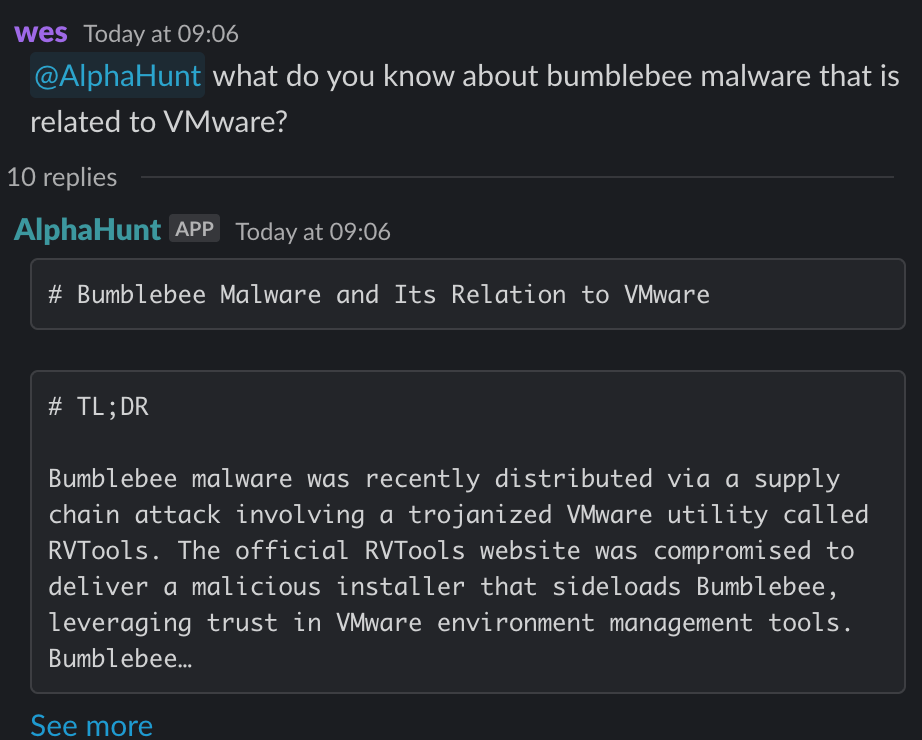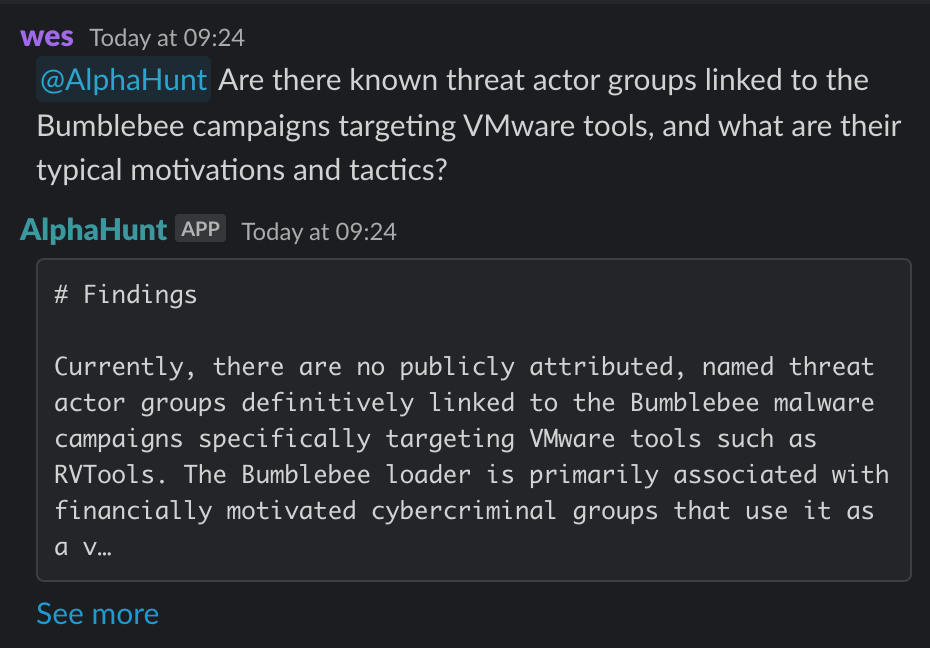Bumblebee Malware Supply Chain Attack: RVTools Compromise, Evolving Tactics, and Strategic Defenses
Bumblebee malware has escalated its tactics by compromising the supply chain of RVTools, a widely used VMware utility, to deliver trojanized installers containing a malicious version.dll loader. This attack, detected in May 2025, distributed malware via both official and typosquatted domains..




(Have feedback? Did something resonate with you? Did something annoy you? Just hit reply! :))
Get questions like this:
- what do you know about bumblebee malware that is related to VMware?
- Are there known threat actor groups linked to the Bumblebee campaigns targeting VMware tools, and what are their typical motivations and tactics?
Does it take a chunks out of your day? Would you like help with the research?
This baseline report was thoughtfully researched and took 10 minutes.. It's meant to be a rough draft for you to enhance with the unique insights that make you an invaluable analyst.
We just did the initial grunt work..
Are you ready to level up your skillset? Get Started Here!
Did this help you? Forward it to a friend!
Suggested Pivot
What specific vulnerabilities or security lapses in the RVTools supply chain enabled the trojanization of the version.dll file, and what technical and procedural controls can be implemented to prevent similar supply chain compromises in VMware-related tools?
TL;DR
Key Points
-
- Bumblebee malware exploited a supply chain compromise of the RVTools VMware utility, delivering trojanized installers via official and typosquatted domains.
- Organizations using VMware tools are at heightened risk; immediate file integrity monitoring and software source validation are critical.
-
- Bumblebee serves as an initial access loader for ransomware and post-exploitation frameworks (e.g., Cobalt Strike), leveraging stealthy techniques like WmiPrvSE.exe manipulation and in-memory payload execution.
- Deploy and tune behavioral detection rules (e.g., SigmaHQ) and enhance EDR telemetry to detect process masquerading and injection.
-
- Despite law enforcement disruptions (e.g., Europol’s Operation Endgame), Bumblebee campaigns persist, with ransomware affiliates and TrickBot splinters (Black Basta, Royal, Silent Ransom) sharing tooling and infrastructure.
- Attribution remains complex; threat intelligence sharing and cross-sector collaboration are essential.
-
- Primary infection vectors include trojanized installers, phishing (malicious LNK/ZIP files), SEO poisoning, and malvertising.
- User awareness training and proactive threat hunting for supply chain and phishing indicators are recommended.
-
- Strategic recommendations include enforcing supply chain security policies, implementing SBOMs, and developing incident response plans for supply chain attacks.
- Executive buy-in and cross-functional coordination are required to mitigate operational, reputational, and regulatory risks.
Executive Summary
Bumblebee malware has escalated its tactics by compromising the supply chain of RVTools, a widely used VMware utility, to deliver trojanized installers containing a malicious version.dll loader. This attack, detected in May 2025, distributed malware via both official and typosquatted domains, leveraging SEO poisoning and malvertising to maximize reach. Dell, the current RVTools owner, denies compromise of official sites, but researchers confirm malicious installers were distributed before domains were taken offline.
Bumblebee, linked to TrickBot affiliates and ransomware groups (including post-Conti splinters), acts as an initial access loader, enabling ransomware deployment, credential theft, and persistent access. The malware employs advanced evasion techniques, such as manipulating WmiPrvSE.exe for process masquerading and in-memory execution, complicating detection and response. Despite international law enforcement actions like Operation Endgame, Bumblebee campaigns have rapidly resurfaced, demonstrating resilience and adaptability.
Targeted sectors include IT, financial services, government, healthcare, and manufacturing, with a geographic focus on the US and Europe. The attack underscores the strategic value of virtualization infrastructure and the growing threat of supply chain compromises. Detection frameworks like SigmaHQ provide experimental rules for identifying Bumblebee’s behavioral patterns, but gaps remain in monitoring file integrity and anomalous changes in trusted software.
Recommended actions include implementing comprehensive file integrity monitoring, deploying and tuning behavioral detection rules, enforcing strict software supply chain policies (including SBOMs and digital signature validation), and enhancing user awareness against phishing. Proactive threat hunting and collaboration with industry peers and law enforcement are vital to counter evolving tactics. The forecast anticipates increased supply chain attacks, more sophisticated evasion, and further decentralization of ransomware ecosystems, with potential expansion into firmware and hardware supply chain vectors in the longer term.
Research & Attribution
Bumblebee malware campaigns targeting VMware tools have been primarily linked to cybercriminal groups associated with ransomware operations, including TrickBot affiliates. Bumblebee replaced the BazarLoader backdoor as an initial access vector in ransomware attacks. Recent campaigns have involved supply chain compromises, notably the trojanization of the RVTools VMware utility installer. This supply chain attack, detected in May 2025, involved a compromised version.dll file within the RVTools installer, identified as a Bumblebee loader variant by multiple antivirus engines. While Dell, the current owner of RVTools, denies compromise of their official sites, security researchers confirm that malicious installers were distributed via official RVTools domains before they were taken offline. Trojanized installers have also been distributed through typosquatted domains, likely promoted via SEO poisoning and malvertising campaigns.
Motivation
The primary motivation behind Bumblebee malware campaigns is financial gain through ransomware and data theft. Bumblebee serves as an initial access loader, facilitating the deployment of ransomware payloads and post-exploitation tools such as Cobalt Strike. The malware enables threat actors to gain persistent access, execute additional malicious payloads, steal credentials, and conduct reconnaissance. The use of supply chain attacks to compromise trusted VMware tools like RVTools indicates a strategic approach to infiltrate enterprise environments and maximize operational impact.
Historical Context
Bumblebee malware has been active since March 2022, initially identified by Google's Threat Analysis Group. It emerged as a replacement for BazarLoader, used by TrickBot affiliates. The malware is distributed primarily through phishing campaigns using malicious LNK files and ZIP archives. In May 2024, Europol coordinated "Operation Endgame," targeting malware droppers including Bumblebee, resulting in arrests and server takedowns across multiple countries. Despite this disruption, Bumblebee campaigns have resurfaced, including the recent RVTools supply chain attack in May 2025, highlighting the malware's persistence and evolving tactics.
Timeline
- March 2022: Bumblebee malware first identified by Google TAG.
- May 2024: Europol's Operation Endgame disrupts Bumblebee operations.
- May 13, 2025: RVTools supply chain attack delivers Bumblebee malware via trojanized installer.
- May 19, 2025: Public reporting and detection of the RVTools compromise and Bumblebee distribution.
- Ongoing: Continued Bumblebee campaigns with evolving tactics, including stealthier payload execution and supply chain compromises.
Countries Targeted
- United States – High concentration of targeted enterprises using VMware tools; primary focus of ransomware campaigns.
- Germany – Part of Europol-coordinated law enforcement actions; targeted in past campaigns.
- United Kingdom – Included in international law enforcement operations; targeted by Bumblebee campaigns.
- Netherlands – Involved in Operation Endgame; targeted by malware campaigns.
- France – Targeted in coordinated law enforcement actions against Bumblebee and related malware.
Sectors Targeted
- Information Technology – VMware tools are widely used in IT environments; supply chain attacks target this sector.
- Financial Services – Ransomware campaigns often target financial institutions for high-value extortion.
- Government – Targeted due to critical infrastructure and sensitive data.
- Healthcare – Increasingly targeted for ransomware and data theft.
- Manufacturing – Targeted for disruption and data exfiltration.
Links to Other Malware
Bumblebee is linked to TrickBot and has replaced BazarLoader as an initial access vector. It is often used in conjunction with ransomware payloads and post-exploitation tools like Cobalt Strike.
Similar Malware
Similar malware families include BazarLoader, IcedID, and other initial access loaders used by ransomware affiliates. Bumblebee shares tactics such as phishing distribution, use of LNK files, and in-memory execution of payloads.
Threat Actors
Threat actors linked to Bumblebee campaigns include TrickBot affiliates and ransomware groups leveraging Bumblebee for initial access. After the Conti ransomware shutdown, many former Conti members splintered into groups such as Black Basta, Royal, and Silent Ransom, who likely continue to use Bumblebee tooling. These actors employ supply chain attacks, phishing, and stealthy execution techniques to infiltrate VMware environments. Attribution remains complex due to overlaps in tooling and shared infrastructure among ransomware-as-a-service (RaaS) groups.
Breaches Involving This Malware
- May 2025: RVTools supply chain attack where the official VMware utility installer was compromised to deliver Bumblebee malware. The compromised installer contained a malicious version.dll file identified as a Bumblebee loader variant. The official RVTools sites were temporarily taken offline amid the incident.
- Previous breaches include phishing campaigns distributing Bumblebee via malicious LNK files and ZIP archives.
SigmaHQ Detection Signatures and Behavioral Rules
SigmaHQ hosts detection rules relevant to Bumblebee malware activity. A notable rule (ID: 1620db43-fde5-45f3-b4d9-45ca6e79e047) detects Bumblebee's manipulation of the WmiPrvSE.exe parent process, a known defense evasion technique (MITRE ATT&CK T1036). This rule monitors process creation events where Bumblebee uses legitimate Windows binaries to execute malicious payloads stealthily. The rule is currently experimental but valuable for detecting Bumblebee's execution patterns.
Limitations and Gaps:
- SigmaHQ rules primarily focus on process execution and manipulation but do not cover supply chain compromise vectors such as trojanized installers.
- Detection gaps exist in monitoring file integrity and anomalous changes in trusted VMware tools like RVTools.
- Behavioral detection could be enhanced by integrating file integrity monitoring, anomaly detection for trusted software, and network traffic analysis for command-and-control communications.
Recommendations:
- Implement file integrity monitoring on critical VMware tools and their installers.
- Deploy SigmaHQ behavioral rules for Bumblebee detection and tune them to reduce false positives.
- Enhance endpoint detection and response (EDR) capabilities to monitor for suspicious parent-child process relationships and in-memory execution.
- Conduct regular threat hunting focused on supply chain attack indicators and anomalous installer behaviors.
Geopolitical Context and Evolving Threat Landscape
Bumblebee campaigns illustrate the adaptive nature of financially motivated cybercriminal groups exploiting supply chain vulnerabilities to infiltrate enterprise environments. The targeting of VMware tools underscores the strategic value of virtualization infrastructure in modern IT. International law enforcement actions, such as Europol's Operation Endgame, have disrupted Bumblebee operations but have not eliminated the threat. These disruptions may drive threat actors to increase supply chain attacks, diversify initial access methods, and adopt stealthier payload execution to evade detection.
The geopolitical landscape involves coordinated multinational efforts to combat ransomware and malware campaigns, with arrests and server takedowns across Europe and North America. However, the persistence and evolution of Bumblebee campaigns highlight the ongoing risk to critical infrastructure and enterprise sectors globally.
Recommendations, Actions, Suggested Pivots, Forecasts and Next Steps..
(Subscribers Only)





